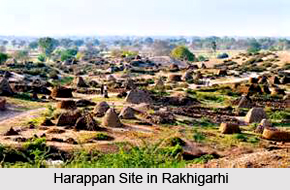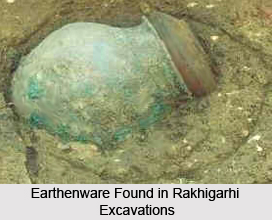 Rakhigarhi, also known as Rakhi Garhi, is a village situated in the Hisar district in the state of Haryana. In the year 1963, the village was discovered to be a part of the Indus Valley Civilization including early Harappan settlements. The village spans over the dry bed of Sarasvati River. The river is believed to flow here in ancient times and dried up by 2000 BC. Archaeological surveys have been conducted in the village which have furnished intriguing historical facts.
Rakhigarhi, also known as Rakhi Garhi, is a village situated in the Hisar district in the state of Haryana. In the year 1963, the village was discovered to be a part of the Indus Valley Civilization including early Harappan settlements. The village spans over the dry bed of Sarasvati River. The river is believed to flow here in ancient times and dried up by 2000 BC. Archaeological surveys have been conducted in the village which have furnished intriguing historical facts.
Rakhigarhi as an Archaeological Site
Archaeological Survey of India started excavating the area since 1997 and has revealed that the lost city had an approximate area of at least 2.2 square kilometres. Several artefacts have also been discovered which are found to be about 5,000 years old. The place was inhabited by the people belonging to early Harappan times. Evidences have been found which consolidates the fact that Rakhigarhi in ancient times had large rainwater collection, drainage system, paved roads, statue production, terracotta brick and storage systems. Remains of metal articles made of bronze or other precious metals have also been found here. Jewellery of this era included bangles of gold, conch shells, Terracotta and semi-precious stones. A granary along with traces of barley has also been found. In Rakhigarhi, five mounds are there which have been named as RGR-1, RGR-2, RGR-3, RGR-4, and RGR-5. Out of five mounds, RGR-4 and RGR-5 are densely inhabited by the people of Rakhishahpur and Rakhikhas villages. Excavations are done on the rest of the mounds.

Archaeological Discoveries of Rakhigarhi
Archaeological excavations in Rakhigarhi have revealed that the place had broad roads measuring about 1.92 metres. In the pottery work, similarity has been found with the pottery of Banawali and Kalibangan. Pits have also been discovered which were surrounded by walls. These are believed to be the sacrificial pits used for certain religious ceremonies. Fire was an important requirement of the religious ceremonies. For handling sewage of the houses, drains lined with bricks were found in the ancient city. Other articles found in the excavations included terracotta seals, needles, copper fish hooks, combs, bronze artefacts, weights and terracotta statues. A bronze vessel adorned with gold and silver and a gold foundry with 3000 unpolished semi-precious stones have also been found. A furnace and tools used for polishing these stones are also discovered. 11 skeletons have been excavated from a burial site and all the heads were in north direction. Certain utensils were also kept near the heads. Shell bangles were found in the left wrists of three female skeletons whereas a gold armlet near one female skeleton. Apart from this, semi precious stones were found near the head indicating that they might be a part of the necklace. Apsidal structures, fire altars and cotton cloth traces preserved on silver or bronze objects also form the artefacts of the excavations. Numerous stamp seals have also been found. The site also houses a cemetery belonging to mature Harappan period and around eight graves have been found there. Wooden coffin have also been excavated.
Harka Civilization in Rakhigarhi
Rakhigarhi have also revealed evidences of Hakra ware which belong to the settlements that date back to the early phase of Indus Valley Civilization. The phase of Harka and early Harappan phase were separated by about 500-600 years and the people of Harka were the earliest dwellers of Indus valley. Based on the articles, the site has been estimated to be of 2500 BC to 3000 BC.
Rakhigarhi has been declared as one of the 10 most endangered heritage sites in Asia by the Global Heritage Fund in May 2012. This unique site has attracted the archaeologists across the globe to explore the early civilizations of the earth.



















